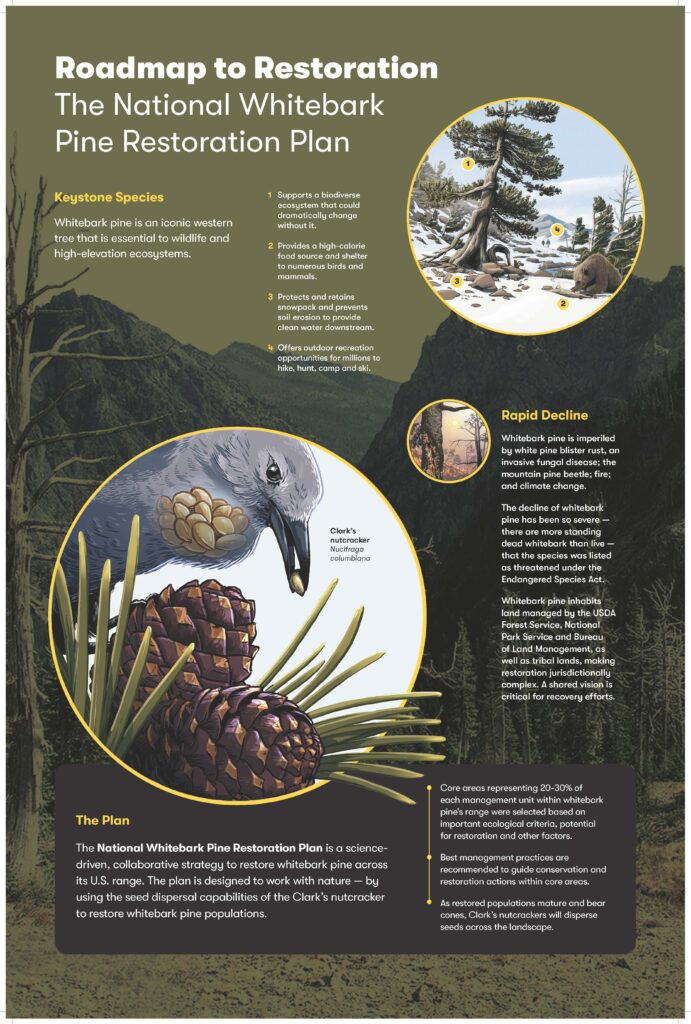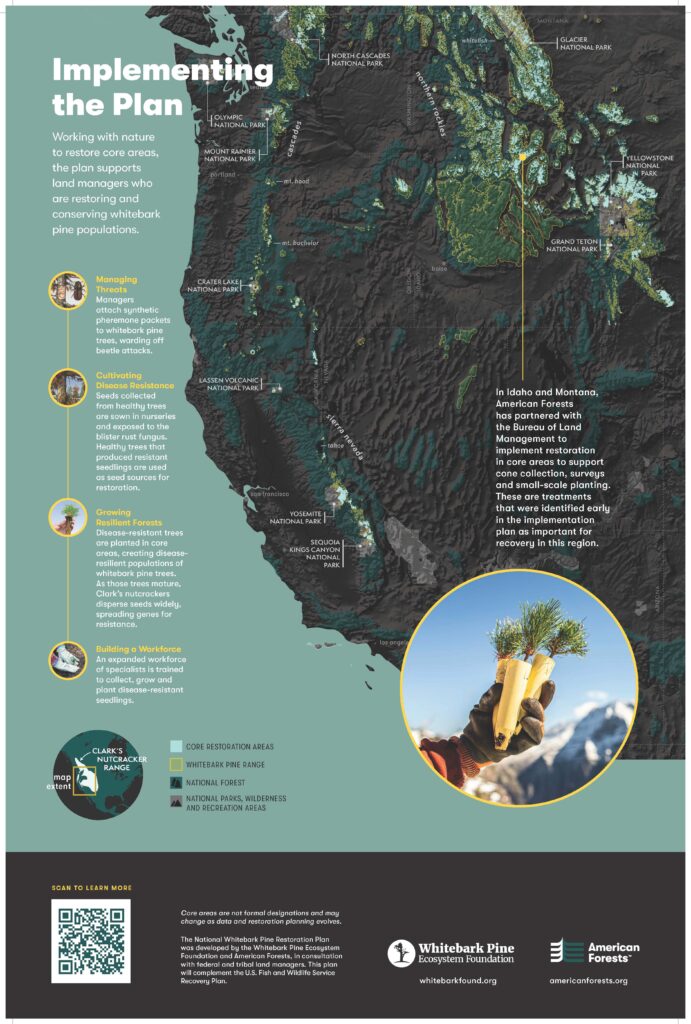Restoration Plan Progress
NWPRP Executive Summary, Fall 2023


Summary: Synopsis and Progress
American Forests, the Whitebark Pine Ecosystem Foundation, and the US Forest Service are collaborating and working with other federal agencies and tribes to develop a core area restoration plan for the U.S. distribution of whitebark pine (Pinus albicaulis)—the National Whitebark Pine Restoration Plan (NWPRP). This strategic plan will identify selected areas within the U. S. range of whitebark pine for priority restoration. The plan will also facilitate fund-raising efforts for restoration. Work through the 2021 federal fiscal year has been funded by the Washington Office of the US Forest Service and by the National Park Service.
The widespread decline in whitebark pine from an unprecedented combination of forest health threats requires timely management intervention. In 2011, the U.S. Fish and Wildlife Service designated whitebark pine as a candidate species under the U.S Endangered Species Act (ESA). The agency determined that listing was “warranted but precluded” in 2012; a Species Status Assessment has been prepared and revised; and, a decision is pending, expected in late spring. Whitebark pine was listed in 2012 as “endangered” under Canada’s Species at Risk Act. I
Key personnel: U.S. Forest Service partners; Wes Swaffar, Northern Rockies Director, American Forests; Diana Tomback, Policy and Outreach Coordinator, Whitebark Pine Ecosystem Foundation.
Rationale and process
Whitebark pine has the largest distribution of any five-needle white pine in North America, but whitebark pine health is deteriorating rapidly across its range, particularly in the Rocky Mountains, Pacific Northwest, and northern Sierra Nevada. Whitebark pine is a keystone and foundation species: regional losses result in reduced high elevation snow retention, reduced forest growth at the highest elevations, less wildlife food and shelter, and reduced forest recovery rates after wildfire. Recently listed as threatened under the U.S. Fish and Wildlife Service’s Endangered Species Act in the U.S., whitebark pine is the most-widely distributed forest tree under ESA protection, with about 75% of the U.S. distribution on U.S. Forest Service lands.
Restoration of whitebark pine poses logistical and fiscal challenges, given the magnitude of its distribution and budgetary constraints. These constraints argue for a strategic approach to restoration, emphasizing designated “core” areas, which will have the highest priority for restoration activities. These core areas should serve as ‘dispersal centers’ for whitebark pine to adjacent regions.
Phase I lead partner–Whitebark Pine Ecosystem Foundation. Main products:
- Nominated core areas for each administrative unit, based on a subset of criteria and with health status. All nominated core areas combined will represent a target proportion (e.g., 20% to 30%) of whitebark pine’s distribution in any administrative unit.
- Map of core restoration areas designated by priority.
- Narrative by agency and geographic unit within the agency.
- Specific restoration protocols assigned to nominated core areas.
- Estimated implementation costs for these restoration protocols.
- Monitoring and adaptive management sub-strategy.
Timeline for Phase I. The timeframe for completion of the draft written plan is winter 2022/2023.
______________________________________________
Steps in completion of Phase 1 of the plan:
- Compile National Restoration Plan.
The Whitebark Pine Ecosystem Foundation in consultation with American Forests will integrate core area information, as well as other important information into the range-wide (national) restoration plan. The final plan will be reviewed and comments will be integrated as the final plan is drafted.
- Present Plan to Leadership and NGOs. Present final plan and begin discussions of implementation strategies.
- Publication of the National Whitebark Pine Restoration Plan. The plan will be published as a report and an executive summary will be published by American Forests.
Phase 2 lead partner—American Forests. Focus on fund-raising in federal, corporate and private sectors for restoration and implementation of the National Whitebark Pine Restoration Plan.

